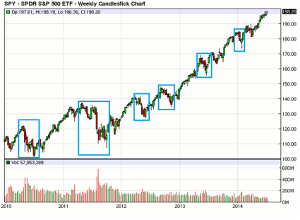Investors and traders alike have lots of choices when it comes to finding vehicles capable of delivering defensive exposure, but each one produces unique results, says Stoyan Bojinov of ETFdb.com.
Corrections are, and always will be, a normal part of the stock market cycle, no matter how much we may fear or despise them. When we consider the fact that the equity market's long-term trajectory is undeniably upward, we can see why prudent market veterans embrace pullbacks, since, after all, every correction is a buying opportunity in disguise.
Investors and traders alike can pick and choose from a variety of exchange-traded instruments in an effort to defend against corrections; with everything from low-volatility to gold ETFs to sector-specific exposure, there is no shortage of options when it comes to seeking out investment vehicles capable of delivering defensive exposure whenever major equity benchmarks head south.
But just how well do some of these assumed-to-be defensive ETFs actually work? Below, we take a look at how some of the most popular safe haven asset classes (excluding bonds) have performed during the biggest broad market pullbacks amid the ongoing five-year bull run. For starters, we have isolated six of the biggest corrections (blue boxes below) since the market bottomed out in 2009; next, we profile the returns for a number of defensive ETFs, starting from the relative broad market peak through the lowest point of each correction.
Click on the button below to see how the "assumed-to-be"Â defensive ETFs performed during each correction. Please note that the dates listed are based on the relative peaks and troughs of the SPDR S&P 500 ETF (SPY) and all returns are based on adjusted daily closing prices.
Click Here
The Bottom Line
Every correction is unique; what this means is that not every safe haven asset class can be expected to deliver the same degree of defensive exposure when selling pressures permeate equity markets. For example, in some of the instances highlighted above, gold has served as a great hedge during stock market corrections, but in others, the precious metal has declined alongside stocks. The takeaway here is that corrections are a normal part of the market cycle and investors may opt for a number of vehicles if they wish to dampen the damage dealt to their portfolios during pullbacks.
By Stoyan Bojinov, Contributor, ETFdb.com



















